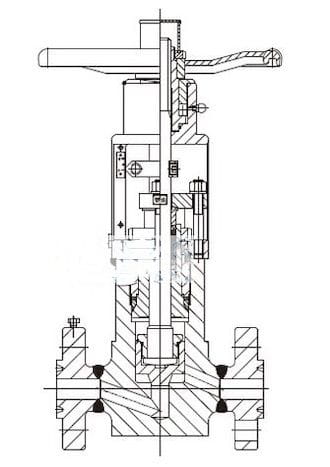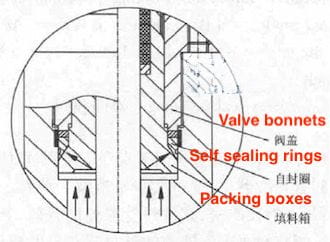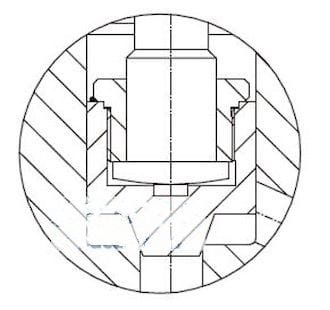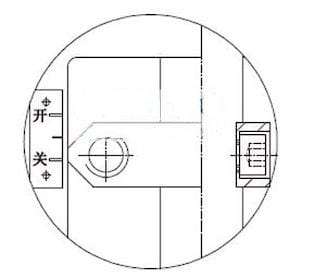1. Overview
With the rapid development of China's economy and industrial modernization, the parameters of large-scale petrochemical and chemical plants are constantly improving, new technologies, new processes, and new devices are constantly emerging, and the requirements for oxygen globe valves are becoming increasingly stringent. An oxygen globe valve with a pressure rating of Class 900 (PN15.0MPa), a v diameter of NPS 1 inch (DN25mm), and a design temperature of 200°C are introduced in this article.
2. Structural characteristics of globe valves
The oxygen globe valve (Figure 1) adopts a low-inlet and high-outflow channel. The flow channel of the valve body is streamlined. The surface of the inner cavity needs to be smooth, with no edges and corners, no sharp corners, no sudden changes, and no unevenness to prevent static electricity. The sealing surface of the valve seat is made from Inconel body alloys, and the valve disc is made from MonelK500 nickel-copper alloys, forming a difference in hardness to ensure the sealing performance. The seal of the middle flange adopts the pressure self-sealing form; the valve bonnet is equipped with an upper seal, and the valve stem is equipped with an anti-rotation mechanism to ensure that the valve stem rises and falls in a straight line.
3. Design
To ensure the safety and reliability of the high-temperature and high-pressure oxygen globe valve, ASTM A182 austenitic stainless steel (304, 304L and other series), GB/T 12225 copper alloy (ZCuZn16Si4I), ASTM494 CY - 40, ASTM B564 (Inconel 600, Inconel 625, Monel 400) and pure nickel are adopted as the main materials. Inconel 600 nickel-chromium-iron alloy has excellent oxidation resistance and stress corrosion resistance at high temperature. To ensure the strength of the valve body, free forging with good compactness is adopted.

Figure 1 High-temperature and high-pressure oxygen globe valves
3.1 Wall thickness of valve bodies
In addition to the strength, the wall thickness of the valve body also considers its stiffness. In order to ensure that the oxygen globe valve has sufficient bearing capacity in high temperature and high pressure, the wall thickness of the valve body is analyzed and calculated by the first strength theory.

where tb is the wall thickness of valve bodies. P is nominal pressure. Dn is the inner diameter of the middle cavity of the valve body.
3.2. Valve bodies and bonnet sealing
The seal between the valve body and the bonnet adopts internal pressure self-sealing, and all materials meet the requirements of Inconel 625. The self-sealing sealing ring is provided with an elastic groove to ensure the elastic effect, and the special sealing angle is matched with the stuffing box; the self-sealing ring and the stuffing box are well sealed through the thread (Figure 2). As the inner cavity pressure increases, the greater the self-sealing ability is, the better the sealing effect becomes. Under high temperature and high pressure, it can resist oxygen corrosion and fully ensure that the valve does not leak.

Figure 2 Valve bodies and bonnet sealing
3.3 The anti-rotation guide of stems
The inner cavity of the valve body and the valve disc have a guiding function (Figure 3) to ensure the coaxiality of the valve disc and the valve seat. The valve bonnet is equipped with an anti-rotation mechanism for the valve stem (Figure 4), so that the valve stem can only move up and down in the opening or closing process of the valve to ensure that there is no rotational friction between the valve disc and the sealing surface of the valve seat, thereby avoiding static sparks.

Figure 3 Disc guides

Figure 4 Anti-rotation mechanism of stems
3.4. Protection
Oxygen valves should be anti-static, anti-grease and dust-proof. Before assembling the valve, all parts including tools should be degreased one by one according to the regulations of JB/T 10530-2005. After the test is passed, degrease again, and clean with oil-free dry nitrogen or air. Store in an oil-free and dust-free space. The oxygen valve should have an anti-static structure. Conductive bolt holes can be provided on the end flange of the valve so that the bolt connection wire can be well grounded to prevent static electricity. There should be a striking mark of no oil on the valve bonnet and a dust cover to prevent oil from entering the cavity. When the oxygen valve is used, the pipeline should be cleaned and degreased to avoid static electricity, causing an explosion and affecting the entire device and even personal safety.
4. Conclusion
Oxygen valves are widely used in petrochemical and chemical equipment, especially in high temperature and high pressure, which have strict requirements on the safety and reliability of the valves. Therefore, factors such as the strength, material, anti-static, and degreasing of the valve should be fully considered in the design and manufacturing process. Fire sources are prohibited during use, and regular maintenance is required to ensure the performance of the valve.